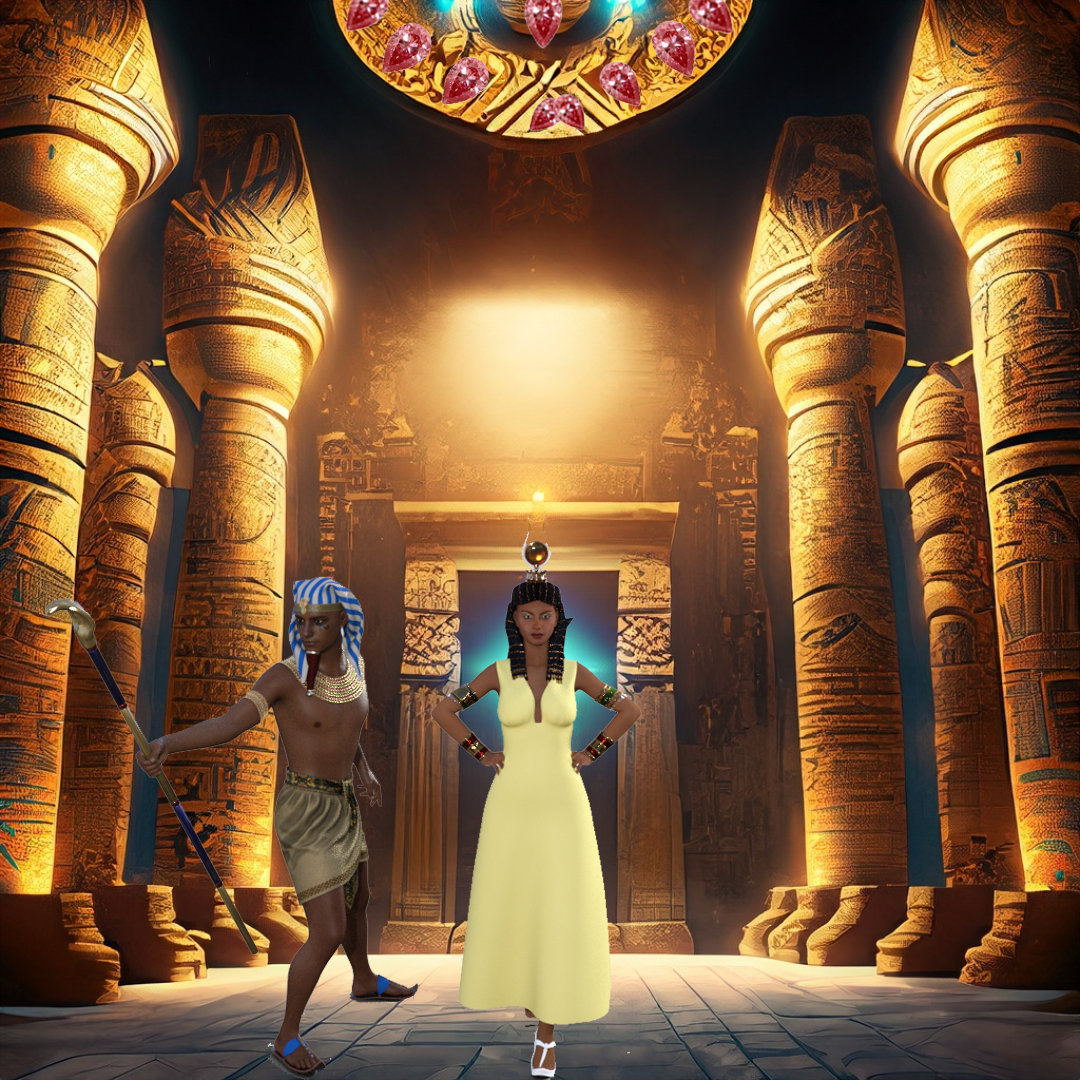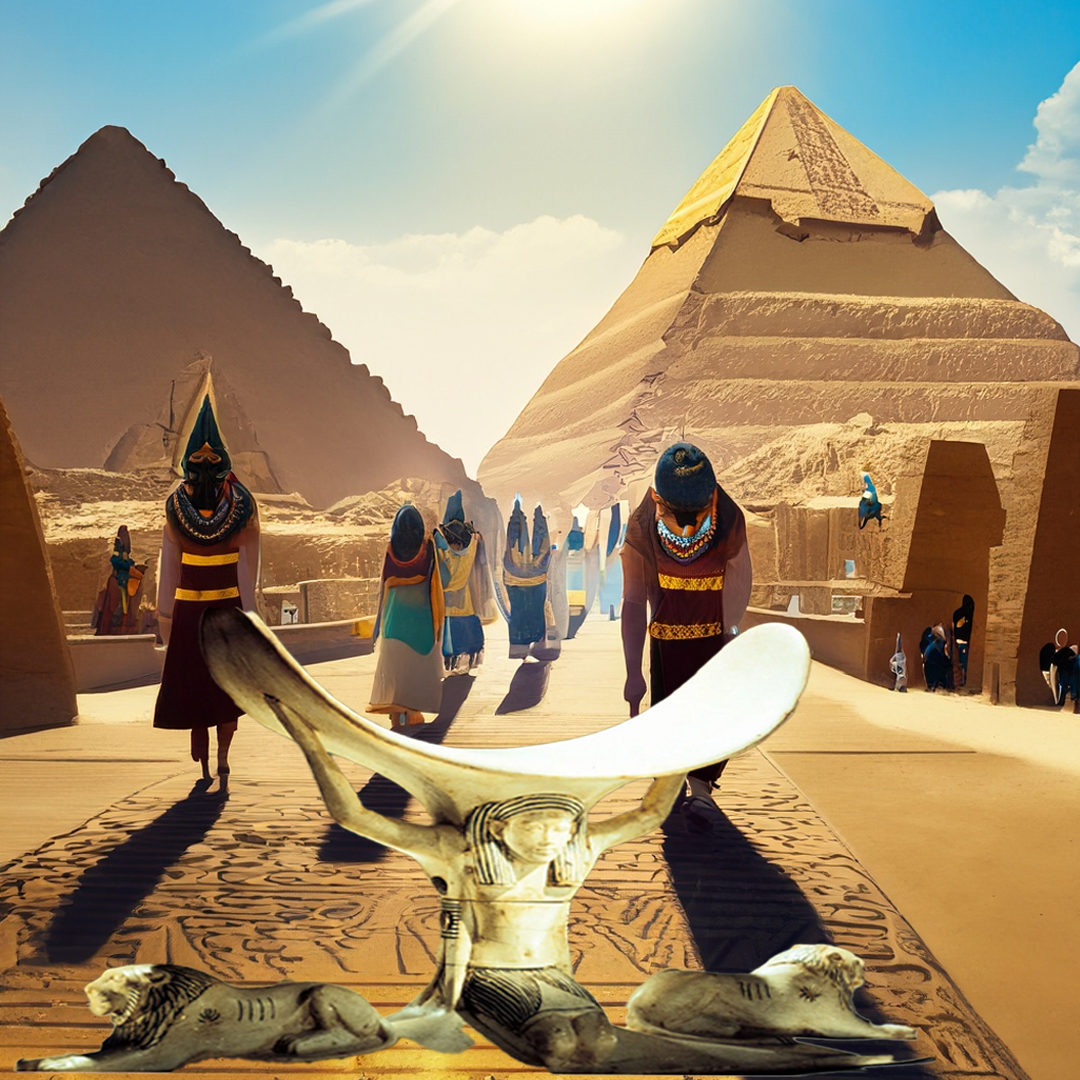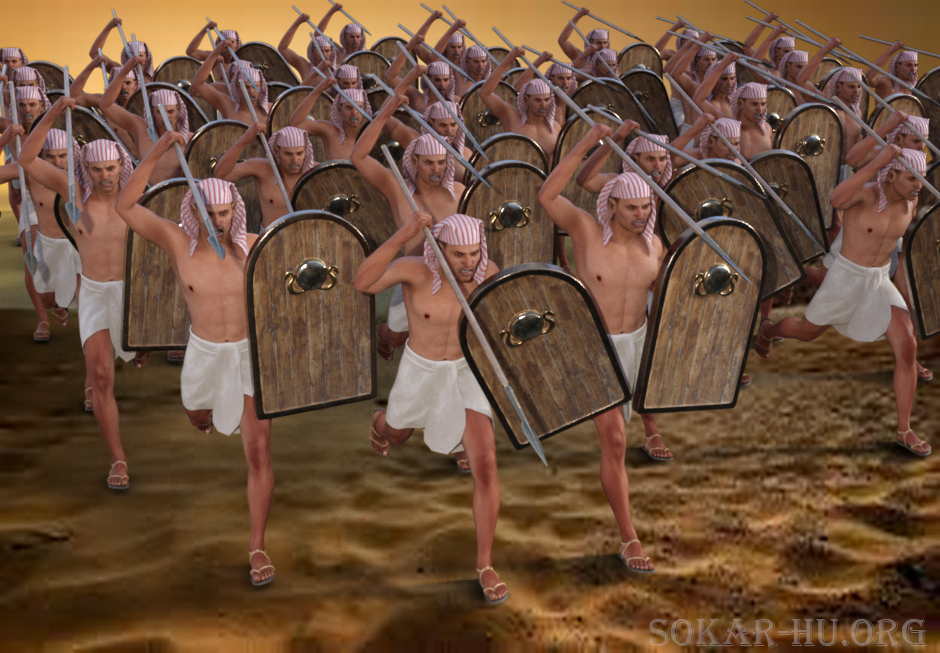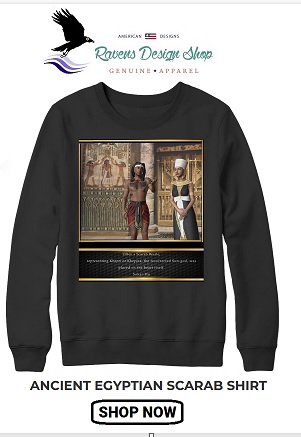King Tutankhamun - A Treasured Legacy in the Valley of the Kings
 The story of Tutankhamun, the boy pharaoh of ancient Egypt, has captivated the world for decades. His tomb, discovered by British archaeologist Howard Carter in 1922, contained a wealth of remarkable treasures, including his iconic golden coffin. This ornate sarcophagus, nestled in the Valley of the Kings, not only served as Tutankhamun's final resting place but also held a trove of approximately 5,000 priceless artifacts. Among them were canopic jars, symbolic footwear, and unique paintings that immortalized the pharaoh's victories over his enemies.
The story of Tutankhamun, the boy pharaoh of ancient Egypt, has captivated the world for decades. His tomb, discovered by British archaeologist Howard Carter in 1922, contained a wealth of remarkable treasures, including his iconic golden coffin. This ornate sarcophagus, nestled in the Valley of the Kings, not only served as Tutankhamun's final resting place but also held a trove of approximately 5,000 priceless artifacts. Among them were canopic jars, symbolic footwear, and unique paintings that immortalized the pharaoh's victories over his enemies.
The Enigmatic Tomb:
Located on the west bank of the Nile River near Luxor, the Valley of the Kings was the chosen burial ground for many pharaohs of the New Kingdom. Tutankhamun's tomb, known as KV62, stands out as one of the most significant archaeological discoveries of all time. The tomb's entrance was concealed beneath debris, which helped to preserve the treasures hidden within for over 3,000 years.
The Golden Coffin:
Tutankhamun's golden coffin, also known as the innermost coffin, remains one of the most iconic symbols of ancient Egypt. This exquisitely crafted sarcophagus was made of solid gold, weighing around 110 kilograms (242 pounds). Its surface was adorned with intricate hieroglyphics and detailed artwork that depicted various aspects of Egyptian mythology.
Within the coffin, Tutankhamun's mummified body rested inside three nested coffins. The outer two coffins were made of gilded wood, while the innermost one, the golden coffin, ensured the eternal preservation of the pharaoh's body. Its design reflected the profound religious beliefs and rituals surrounding death and the afterlife in ancient Egypt.
The Priceless Treasures:
The burial chamber contained a staggering number of treasures, ranging from canopic jars to Tutankhamun's personal belongings. Canopic jars, intricately decorated containers, housed the embalmed organs of the pharaoh. Each jar featured a different lid, representing one of the four protective deities associated with the organs they held.
Among the treasures, Tutankhamun's dazzling footwear stood out as a testament to his power and victories. Some of these shoes, adorned with elaborate designs and made of precious materials, featured paintings of his enemies on the soles. This unique design choice served as a symbolic representation of the pharaoh trampling over his foes with every step he took. It further reinforced the belief in Tutankhamun's divine supremacy and his ability to conquer all opposition.
A Glimpse into Ancient Egypt:
Tutankhamun's golden coffin and the accompanying treasures provide an unparalleled insight into the opulence and grandeur of ancient Egyptian civilization. They showcase the exceptional craftsmanship of the time, as well as the intricate religious and cultural practices surrounding death and the afterlife.
The discovery of Tutankhamun's tomb not only shed light on the life and death of the young pharaoh but also revealed important historical and archaeological details about the period in which he lived. The artifacts found within the tomb have not only captivated experts and scholars but have also enraptured the imaginations of people worldwide, sparking a fascination with ancient Egypt that continues to this day.
Preserving the Legacy:
Since the discovery of Tutankhamun's tomb, efforts have been made to preserve and protect the treasures within. Some of the artifacts have been displayed in museums worldwide, enabling millions of people to experience the wonder and beauty of ancient Egypt. These artifacts serve as a testament to the rich cultural heritage of Egypt and the significance of Tutankhamun's reign.
Tutankhamun's golden coffin and the countless treasures interred alongside him in the Valley of the Kings stand as a testament to the splendor and magnificence of ancient Egyptian civilization. From the intricate canopic jars containing his organs to the symbolic footwear depicting paintings of his enemies on the soles, these artifacts offer a glimpse into the life, power, and victories of the boy pharaoh. As we continue to unearth the mysteries of ancient Egypt, Tutankhamun's golden coffin remains a shimmering symbol of an extraordinary era long past.
The Majestic Headrest: A Divine Tribute in Tutankhamun's Tomb
 The tomb of Tutankhamun, the boy pharaoh of ancient Egypt, captivated the world when it was discovered by Howard Carter in 1922. Amidst the treasure trove of artifacts found within, one particular item stands out as a remarkable masterpiece of art and symbolism—the Headrest in the form of the god Shu with two crouching lions. This intricately crafted piece offers a glimpse into the artistic and religious traditions of ancient Egypt while showcasing the divine reverence and opulence associated with Tutankhamun's burial.
The tomb of Tutankhamun, the boy pharaoh of ancient Egypt, captivated the world when it was discovered by Howard Carter in 1922. Amidst the treasure trove of artifacts found within, one particular item stands out as a remarkable masterpiece of art and symbolism—the Headrest in the form of the god Shu with two crouching lions. This intricately crafted piece offers a glimpse into the artistic and religious traditions of ancient Egypt while showcasing the divine reverence and opulence associated with Tutankhamun's burial.
Unraveling the Mystery:
The Headrest in the form of the god Shu with two crouching lions is an artifact that embodies the fusion of religious beliefs and artistic craftsmanship of the New Kingdom period. The headrest itself serves as a practical object, used to support the neck and head during sleep. However, the significance of this particular headrest goes beyond its functional purpose. It is believed to represent the eternal connection between the deceased pharaoh and the divine realm.
Symbolism and Divine Representation:
The god Shu, represented in the headrest, was an important deity in ancient Egyptian mythology. As the personification of air and the father of the sky goddess Nut and the earth god Geb, Shu held a vital role in the creation myth and the maintenance of cosmic order. The inclusion of the god Shu on the headrest symbolizes his protective presence over Tutankhamun's eternal rest.
The two crouching lions depicted on either side of the headrest add an additional layer of symbolism. In ancient Egyptian mythology, lions were often associated with power, protection, and royalty. By including these regal beasts, the artist intended to emphasize Tutankhamun's authority and divine lineage. The presence of lions also reflects the concept of duality—a recurring theme in ancient Egyptian art—wherein the lion's association with both the terrestrial and divine realms bridges the gap between the mortal and immortal.
Artistic Excellence:
The headrest itself is a testament to the skill and artistry of the ancient Egyptian craftsmen. Made from wood and covered with gold sheeting, the headrest showcases the high level of technical proficiency possessed by the artisans of the time. The intricate detailing on the lions' manes, the delicate carvings on the god Shu's figure, and the overall symmetrical composition highlight the meticulousness with which the piece was created.
Preservation and Legacy:
Following its discovery in Tutankhamun's tomb, the Headrest in the form of the god Shu with two crouching lions underwent extensive restoration to ensure its preservation. Today, it resides in the Egyptian Museum in Cairo, where it continues to captivate visitors from around the world, allowing them to appreciate the rich cultural and historical heritage of ancient Egypt.
The Headrest in the form of the god Shu with two crouching lions from the tomb of Tutankhamun serves as an extraordinary testament to the artistry, symbolism, and religious beliefs of ancient Egypt. Its representation of the god Shu, the presence of the majestic lions, and the exceptional craftsmanship all contribute to its status as a remarkable artifact. As we marvel at the intricate details of this headrest, we are reminded of the enduring power and magnificence of the pharaohs and their connection to the divine world.
The Art of War

King Tutankhamun warriors were skilled in the art of war.
King Tutankhamun was known throughout ancient Egypt for his great prowess in battle. He was a warrior king who had been trained from a young age in the art of war, and his armies were among the most skilled and disciplined in the world.
The king's warriors were a formidable force, feared by their enemies for their strength, agility, and ferocity in battle. They were trained in a wide variety of weapons and fighting techniques, and they were well-versed in the tactics of both offense and defense.
One of their most famous battles was against the invading army of the Hittites, who had marched into Egypt with the intention of conquering the land and seizing its riches.
But King Tutankhamun and his warriors were ready for them. They had been preparing for months, honing their skills and building up their defenses, and when the Hittites arrived, they were met with a fierce and determined resistance.
The two armies clashed on the battlefield, with the Hittites using their superior numbers and weapons to try and overwhelm the Egyptians. But King Tutankhamun and his warriors fought with a skill and bravery that was unmatched, cutting down the enemy soldiers one by one and driving them back with a ferocity that left even the most hardened warriors trembling with fear.
In the end, the Hittite army was defeated, and King Tutankhamun emerged victorious. His warriors had proven themselves to be the finest soldiers in all of Egypt, and their skill and courage had secured the safety and security of their kingdom.
As the king surveyed the battlefield, he knew that he owed his victory not just to his own courage and leadership, but to the dedication and skill of his warriors. They had fought with everything they had, and they had emerged victorious against impossible odds.
And so, King Tutankhamun made sure that his warriors were honored and respected throughout the kingdom, with their bravery and skill celebrated in song and story for generations to come. For in the end, it was their courage and dedication that had secured the future of Egypt, and ensured that the kingdom would endure for centuries to come.

King Tutankhamun Walks With His Favorite Lion
King Tutankhamun had a great love for big cats, often taking time to walk his favorite domesticated lion. The lion was God's symbol depicting King Tutankhamun's strength and his mastery over the natural world.
King Tutankhamun was known for his love of big cats, and he often spent time with his favorite domesticated lion, whom he had named Amun. The lion was a symbol of the king's strength and his mastery over the natural world, and the two were inseparable companions.
One day, as the king and his lion were taking a walk in the desert, they came across a group of bandits who had been causing trouble in the region. The bandits were armed and dangerous, and they quickly surrounded the king and his lion, demanding that he hand over his valuables.
King Tutankhamun, however, was not easily intimidated. He stood tall and commanded his lion to roar, a sound that echoed across the desert and filled the bandits with fear. Amun growled and bared his teeth, his powerful muscles rippling beneath his fur.
The bandits were no match for the king and his lion, and they quickly fled, leaving behind their stolen loot. King Tutankhamun and Amun triumphantly returned to the palace, the king's pride in his companion evident in the way he stroked the lion's mane.
From that day forward, the king and his lion were known as a formidable pair, feared and respected by all who encountered them. Amun became a symbol of the king's strength and his ability to overcome any challenge, and the people of Egypt looked to their king and his lion as an example of true courage and bravery.
As for King Tutankhamun himself, he continued to walk with his beloved lion, relishing in the power and strength that he had gained through their partnership. For him, there was no greater joy than spending time with Amun, the lion who had become his closest friend and most trusted companion.

